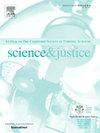窒息死亡的准确法医鉴定:利用ATR-FTIR光谱区分勒死和溺水
IF 1.9
4区 医学
Q2 MEDICINE, LEGAL
引用次数: 0
摘要
窒息死亡是暴力死亡的主要原因,勒死在谋杀和家庭虐待案件中更为常见,而溺水是意外死亡的最常见原因之一。因此,对这两种死因的研究,有利于保障司法公正,提高刑事案件侦破率。本研究探讨了ATR-FTIR光谱作为区分法医自溶尸体和腐烂尸体的勒死和溺水方法的可行性。利用C57BL/6小鼠死亡模型,采用ATR-FTIR光谱分析死后肺组织样本,同时采用苏木精和伊红(HE)染色等传统组织学方法。采用主成分分析(PCA)和偏最小二乘判别分析(PLSDA)来提高光谱数据的解释,在区分两种死亡原因方面显示出较高的准确性。PLSDA模型在绞杀和溺水死因鉴定的外部验证中显示出100%的准确性,突出了ATR-FTIR光谱与机器学习算法相结合在法医应用中的潜力。结果显示,在与酰胺带、蛋白质二级结构和核酸相关的光谱峰中观察到明显的变化,具有明显的绞杀和溺水的生化特征。ATR-FTIR光谱的集成为法医调查员提供了一种无损、快速、可靠的方法,特别是当传统的尸检结果由于自溶和腐烂而无法确定时。该研究强调了将ATR-FTIR光谱与组织病理学检查和化学计量学相结合,以提高法医调查的准确性和可靠性,并支持司法行政的重要性。本文章由计算机程序翻译,如有差异,请以英文原文为准。
Accurate forensic identification of asphyxial deaths: Differentiating strangulation and drowning using ATR-FTIR spectroscopy
Asphyxial death is a leading cause of violent death, strangulation is more frequently seen in murder and domestic abuse cases, while drowning is one of the most common causes of accidental death. Therefore, studies on these two causes of death are beneficial to ensuring the administration of justice and increasing detection rate of criminal cases. This study investigated the viability of ATR-FTIR spectroscopy as a method for distinguishing between strangulation and drowning in autolysis and putrefaction cadavers of forensic cases. Utilizing C57BL/6 mice death models, lung tissue samples were analyzed post-mortem using ATR-FTIR spectroscopy, alongside traditional histological methods such as Hematoxylin and Eosin (HE) staining. Principal Component Analysis (PCA) and Partial Least Squares Discriminant Analysis (PLSDA) were employed to enhance the spectral data interpretation, demonstrating high accuracy in distinguishing between the two causes of death. The PLSDA model showed a 100 % accuracy in external validations for strangulation and drowning cause of death identification, highlighting the potential of ATR-FTIR spectroscopy combined with machine learning algorithms in forensic applications. The results revealed distinct biochemical signatures for strangulation and drowning, with significant changes observed in the spectral peaks associated with Amide band, protein secondary structures and nucleic acids. The integration of ATR-FTIR spectroscopy provides a non-destructive, rapid, and reliable method for forensic investigators, especially when traditional autopsy results are inconclusive due to autolysis and putrefaction. The study emphasizes how crucial it is to combine ATR-FTIR spectroscopic with histopathological examination and chemometrics to increase the precision and dependability of forensic investigations and support the administration of justice.
求助全文
通过发布文献求助,成功后即可免费获取论文全文。
去求助
来源期刊

Science & Justice
医学-病理学
CiteScore
4.20
自引率
15.80%
发文量
98
审稿时长
81 days
期刊介绍:
Science & Justice provides a forum to promote communication and publication of original articles, reviews and correspondence on subjects that spark debates within the Forensic Science Community and the criminal justice sector. The journal provides a medium whereby all aspects of applying science to legal proceedings can be debated and progressed. Science & Justice is published six times a year, and will be of interest primarily to practising forensic scientists and their colleagues in related fields. It is chiefly concerned with the publication of formal scientific papers, in keeping with its international learned status, but will not accept any article describing experimentation on animals which does not meet strict ethical standards.
Promote communication and informed debate within the Forensic Science Community and the criminal justice sector.
To promote the publication of learned and original research findings from all areas of the forensic sciences and by so doing to advance the profession.
To promote the publication of case based material by way of case reviews.
To promote the publication of conference proceedings which are of interest to the forensic science community.
To provide a medium whereby all aspects of applying science to legal proceedings can be debated and progressed.
To appeal to all those with an interest in the forensic sciences.
 求助内容:
求助内容: 应助结果提醒方式:
应助结果提醒方式:


